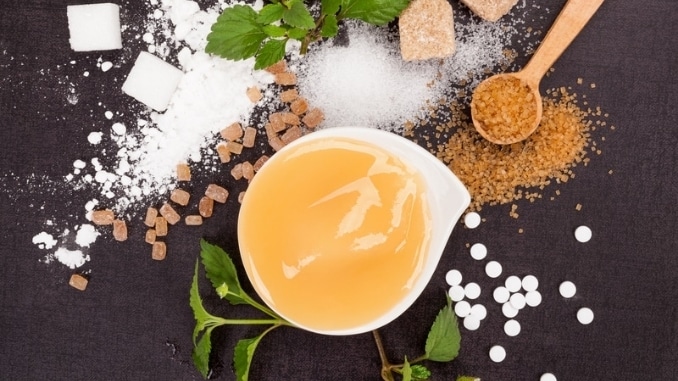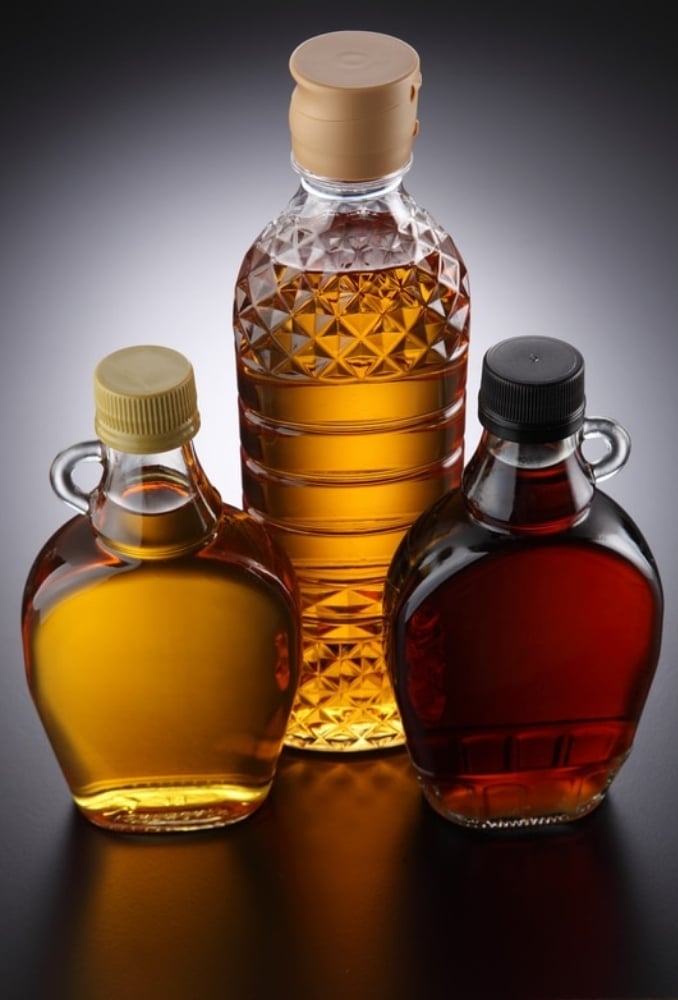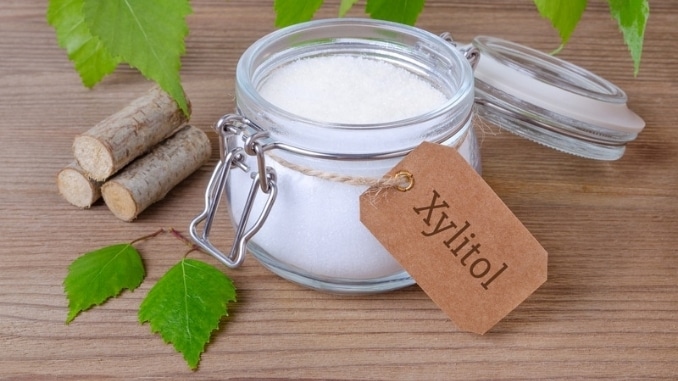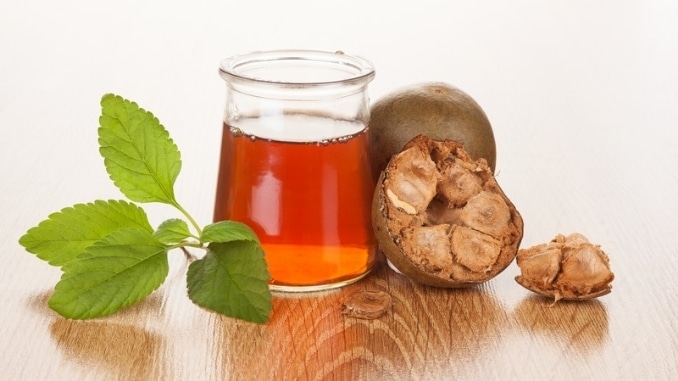
With the turn toward a healthier diet and lifestyle, sugar alternatives have gained popularity. We all know that refined sugar is not your friend. However, don’t be too quick to jump on the sugar-free bandwagon either. Some sugar alternatives are excellent and healthy for us. However, there are also some out there that have unpleasant side effects and may even cause health problems.

We’ve researched the most common sugar alternatives — both natural and manufactured. There are a few that we recommend, and some we’ll advise you to avoid. Read on to get a better understanding of what makes those sugar-free chocolate bars taste so sweet.
Stevia
Stevia is truly an all-natural sweetener. It is derived from the leaves of the Stevia Rebaudiana plant that’s native to parts of South America. The plant is easy to grow in your backyard or indoors. You can use the leaf fresh or dried to sweeten beverages and baked goods.
Stevia has no calories and does not affect blood glucose levels. It is much sweeter than sugar, so use it sparingly until you find a good level for your sweetening preference. Some people don’t like the taste of store-bought stevia powders and extracts. Some brands are less pure than others and can have a chemical or bitter aftertaste. If you’ve tried stevia in the past and didn’t like the aftertaste, try another brand. Avoid brands containing maltodextrin and dextrose. Also, adding a bit of Himalayan pink salt with stevia may help balance out the bitterness.
What Are the Health Benefits, Risks and Side Effects of Stevia?
Stevia has no side effects. However, there are some reports of a possible drug interaction with lithium. Stevia may also lower blood sugar levels. So, if you’re already taking medication for diabetes, talk with your doctor about the safety of using stevia. While no evidence has shown that taking stevia while you’re pregnant is a problem to your unborn child, some people recommend avoiding stevia while you’re pregnant or nursing.
In some research, stevia has been shown to kill cancer cells. It can also help lower your blood sugar.
Sucralose
Sucralose is widely marketed under the trade name of Splenda. Sucralose is a lab-created sweetener. It was discovered by accident when researchers were developing a new pesticide. It’s made by removing some hydroxyl atoms from sugar and replacing them with chlorine atoms. Sucralose if often found in baked goods, soft drinks and specialty blends for baking.
What Are the Health Benefits, Risks and Side Effects of Sucralose?
Sucralose is not a healthy sugar substitute. It has been shown to cause migraine headaches, decrease beneficial gut flora and is linked to certain types of cancer.
Aspartame
Aspartame is another lab-created sweetener. It is found in most brands of chewing gum, breath mints, and diet soda. Aspartame is also often on the ingredient list in low-calorie or “light” foods like yogurt and canned fruit. Aspartame is in lots of foods marketed to children. It is also in chewable and liquid medicines.
What Are the Health Benefits, Risks and Side Effects of Aspartame?
Since the introduction of aspartame in the 1980s, its safety has been questioned. While the United States Food and Drug Administration (FDA) maintains that aspartame is a safe food additive, multiple studies have shown that aspartame is not at all safe.
A 2007 study showed that animals given a low dose of aspartame daily were more likely to develop cancer than those who didn’t consume it. Another study, published in 2012, found that men who drank diet soda each day were more likely to develop non-Hodgkin’s lymphoma than those who did not consume aspartame.
Aspartame is also classified as an excitotoxin. An excitotoxin is a neurotransmitter that binds with nerve cells in the body and kills or damages the cells because of excessive stimulation. Multiple neurological disorders, Parkinson’s disease, hearing loss, and other health conditions have been linked to excitotoxins like aspartame and monosodium glutamate.
Agave Nectar
Sometime in the early 2000s, agave nectar was introduced as a healthy alternative to sugar. Agave nectar is a sweet brown syrup made from the agave plant — the same plant used to make tequila. Agave nectar is sweeter than sugar due to its fructose content. It tastes very similar to sugar and makes a good replacement for sugar in baked goods, drinks, and sauces.
What Are the Health Benefits, Risks and Side Effects of Agave Nectar?
While many well-known nutrition gurus enthusiastically embraced agave nectar when it was first made popular, the sweetener has recently faced criticism.
At first, people were excited about the fact that agave nectar has a lower glycemic index than regular sugar. The glycemic index is a scale of the effect of particular foods on blood sugar levels in the body. A sweetener with a lower glycemic index than sugar is attractive.
However, what all the nutrition experts failed to recognize is that agave nectar contains between 70 and 90 percent fructose by weight. Sugar, on the other hand, contains 50 percent fructose and 50 percent glucose while high fructose corn syrup contains 55 percent fructose and 45 percent glucose. So, the once loved agave nectar contains more fructose than high fructose corn syrup. As you might have imagined, health experts far and wide are eating their words now that we know that agave nectar may be more harmful than even sugar.
The body doesn’t process fructose in the same way it processes glucose. Fructose doesn’t promote insulin production or leptin secretion in the body. Insulin and leptin help us to regulate both appetite and fat storage. It’s been shown that high levels of fructose cause the body to store calories as fat and leads people to overeat because they don’t experience the feeling of fullness. A U.S. Department of Agriculture (USDA) study in rats shows that a diet high in fructose decreases fertility, causes high cholesterol, copper deficiency, and enlarged hearts.
In the same way that we don’t recommend high fructose corn syrup, we also advise against using agave nectar to sweeten your foods and beverages. A small amount of agave nectar, from time to time, won’t kill you. However, it isn’t the healthy, nutritive sweetener that many of us once thought it was.
Sugar Alcohols
Sugar alcohols are carbohydrates made up of a sugar molecule and an alcohol molecule. This chemical reorganization produces a sweetener that has fewer calories than sugar. The carbohydrates from sugar alcohols are not effectively absorbed into the body.
Common sugar alcohols that we see in foods and beverages are sorbitol, erythritol, mannitol, and xylitol. Sugar alcohols are sweet like sugar. They can be used easily in baking and are often found in sugar-free candies.
What Are the Health Benefits, Risks and Side Effects of Sugar Alcohols?
The major benefit of sugar alcohols is that they don’t affect the endocrine system in the way that sugar does. The food tastes sweet but has virtually no digested carbohydrates. The caloric difference is also a bonus. Sugar alcohols have very little calories compared to sugar-sweetened treats.
Xylitol is one sugar alcohol that is also good for the teeth. Studies show that people who use dental products with xylitol have fewer cavities than those who do not.
The side effects of sugar alcohols, however, are particularly concerning. Because these carbohydrates go all the way through the digestive system without being absorbed, they can cause cramping, gas, bloating and diarrhea.
It is true that some sugar alcohols are more easily tolerated than others. Erythritol is one, in particular, that causes very little digestive symptoms when it’s consumed in normal amounts. Most of the time, even children can safely consume foods sweetened with erythritol without any digestive complaints.
The other sugar alcohols may taste good, but they are reported to cause digestive pain when eaten often or in large amounts. Gas and bloating are among the most common side effects.
Monk Fruit
Discovered and first used by Buddhist monks in the 1200s, monk fruit is a melon-like fruit native to southeast Asia. Monk fruit is sweeter than sugar, has no calories and doesn’t affect the body’s blood sugar levels. Monk fruit is turning up in all sorts of foods and beverages like yogurt, ice cream, chocolate bars, and sparkling drinks.
What Are the Health Benefits, Risks and Side Effects of Monk Fruit?
Monk fruit appears to be a very safe and high-quality sweetener. In the benefits category, monk fruit has been shown to help improve diabetes by promoting better insulin secretion in the body. Some studies have shown that monk fruit fights inflammation and kills cancer cells.
One reservation we have about monk fruit is that it has not been on the food additive scene for very long. So, this sugar alternative’s effects haven’t been studied much. This is a big issue, considering the agave nectar craze. Monk fruit is also not easy to grow in many climates, which means it’s harder to find. It is expensive to import monk fruit. This sweetener carries a higher price tag than others. Aside from those concerns, monk fruit seems to be a safe and healthy sugar alternative.
Choose Your Sugar Alternatives Wisely
When you’ve got a craving for sweets, but you don’t want to eat sugar, there are plenty of options out there these days. Look for the most natural sugar alternatives with the least side effects. Stay far away from aspartame and sucralose and don’t go overboard with any sugar alternatives. Do your homework and choose your sugar alternatives wisely.
For your guide to managing high blood sugar, check out our 14-Day Diabetes Control Quick Start Program, here!





